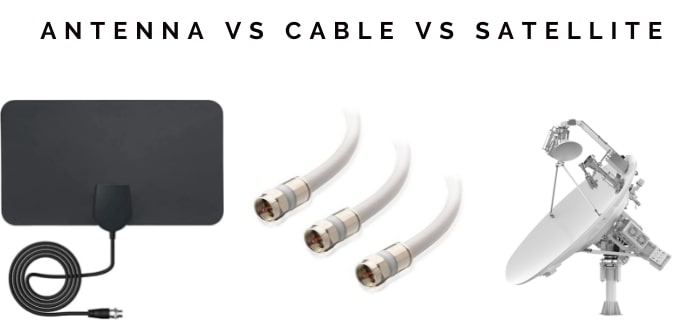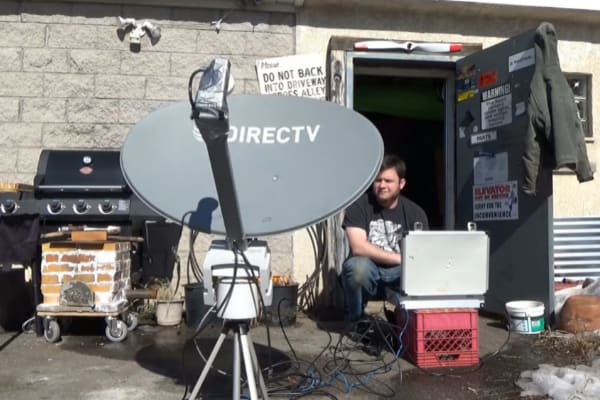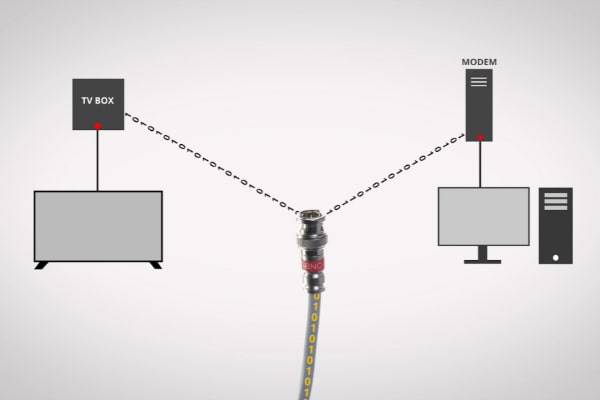Signal transmission system for Television has evolved day by day. People now have different options for their TV and ask questions like –Antenna vs Cable vs Satellite, which one is more reliable? Well, among all Cable signal transmission stands out in the present era.
You might be wondering why Cable connection wins the match. Don’t worry, we got you covered here. Although different transmission systems have their own pros and cons, you’ll get to know here why Cable is the best.
So, without further delay, let’s get started with the details.

Comparison Chart – Antenna Vs Cable Vs Satellite
Take a look at the quick comparison chart below to understand more clearly about Antenna vs Cable vs Satellite TV.
| Comparison Factors | Antenna TV | Cable TV | Satellite TV |
| Affordability | Best affordable. Antenna comes in $10-$40. No monthly charge. | More affordable plans. Maximum price $105. Monthly charge starts at $50 | Least affordable. Maximum price $150. Monthly charge starts at $70 |
| Reliability | Reliable but issues in bad weather. | More reliable and secured connection service. | Less reliable in adverse weather. |
| Availability | Available near broadcasting towers. | Available at a certain area coverage. | Available in a larger area that the satellite covers. |
| Data Compression | Does not compress any data | Modulates data, sometimes compresses | Compresses data |
| Best Use For | Fixed home TV near the broadcasting tower. | Fixed area that the DBS provider covers through Coaxial cable. | Rural area where Cable can’t reach. |
What Is Satellite TV?

Satellite TV is the most recent form of signal transmission system for Televisions. In simple words, in Satellite TV you get your TV signal transmitted through Satellite.
It means, the signals have to travel from the program source through two satellites and finally reach you.
The satellite is placed at the geostationary orbit that revolves around the earth. Signals are transmitted from the satellite and thus the satellite TV works.
You might wonder how the thing practically works in TV communication.
Let’s shed some light into a clear explanation. Before that, get something straight about the Orbit rotating system and Satellite basics.
- The Rotation Of Earth
You already know the earth revolves around the sun as well as on its own axis. The placed satellite should rotate at the same speed as the earth rotation. So, it takes 24 hours to complete a rotation.
- Geostationary Orbit
There is speed information from the force balance equation of the gravitational and centrifugal forces. The satellite needs no relative motion condition to work and an orbit radius is required for that.
It is exactly 42,164 kilometers. This orbit is called the geostationary orbit. The satellites used for satellite TV are parked in this orbit and already crowded.
Now, comes the Satellite.
How Satellites Run – The Energy Source
A Satellite runs with energy stored by its solar panels. When the satellite is not facing the sun, it works with the insulated battery pack and continues the operations.
How Do Satellites Stay In The Same Place?
You may be thinking, as there are many satellites in the geostationary orbit, how do they align and stay at the same place?
Well, Satellites have small engines which are named Thrusters. The thruster produces a minimal force and keeps the orientation and position always the same as the satellite.
Let’s get into the communication section now.
How Satellites Are Used In Television Communication
The Transponder of a Satellite is the core element for TV satellite communication. Transponders receive signals from the base station on earth and transmit the signals again to your dish antenna.
However, the process is more complex than said. Let’s explore how the system actually works in reality.
Detailed Process Of A Satellite’s Work
Massive channels such as CNN create a lot of content 24/7. The channel stations are called program source. Once the content is created, the huge data is sent through video signals to TV broadcast networks which are DBS (Direct Satellite TV) providers.
But the channels need to transmit the programs right after creating the content. They add their advertisements. Then, they transmit it to a DBS provider (one point). Once the video signals are transmitted, other DBS providers can get the contents through business deals.
How DBS Providers Play Their Role In Satellite TV?
A single DBS provider collects so many channels likewise and clubs the contents together. Then, they compress the signals, standardize the bit rate, and encrypt them.
Once the video signals are ready to go to the next level, DBS providers beam the signal to their rented transponders in a Satellite.
Here, DBS providers don’t rent one transponder, they rent many to handle the huge amount of data they have to deliver. That’s how you can enjoy 300-400 channels from a single DBS provider.
Before sending the signals back to earth, the transponder removes noise and amplifies the signals’ power.
How Does The Data Transmits To Our Television
Now, the final data is transmitted to your receiver antenna, also known as dish antenna. You have to angle your receiver’s antenna (Dish Antenna) facing towards your DBS provider’s satellite.
Different receiver antennas can face in different directions in the same location too. It happens when a different DBS provider’s satellite is used for signal transmission in the same location.
- Note:
Remember, the signal frequencies are different for uplink and downlink transmission. Once your dish captures the signal, the signal is decoded with the help of your dedicated card (TV Card) in your set top box to prevent piracy and errors.
Why Is Data Transmission Delayed?
As data transmission has to go a long way through two satellites, it delays for a few seconds to show up. That’s why live events are also delayed by 0.5 seconds minimum to display on your Television.
Read more: can I use satellite cable for TV antenna
What Is Cable TV?
Cable TV is basically a TV program system run by cable. You can say a bunch of cables instead. All the channels are adjoined in one thick coaxial cable that runs to your home and lets you enjoy several TV programs.
How Cable TV works?

Cable TV signal transmission also uses Satellite but the network is provided in a different way. The signals beam to the satellite and delivered to local cable companies.
There are big Antenna Farms, which includes giant antennas that can receive a huge amount of data and combine them all in one place.
Cable companies take the feeds from different sources and modulate them in 200 different 6 Megahertz channels. They’re transmitted into a Coaxial cable and run through the down lines of the houses.
As cable connections can’t go too far because the signal gets weak, the providers use signal amplifiers to boost the signals.
Digital Cable
Nowadays, cable TV has enhanced its functioning. Now they are able to combine 800 channels to a network signal with the help of a MPEG encoder and they are fit to six megahertz channels. This is called digital TV.
What Is TV Antenna?

Antenna TV is the easiest signal transmission system. You must have seen several broadcasting towers in your area or nearby. Did you ever think, what do they actually do?
Well, these are the towers that broadcast or transmit signals directly to your Television. It works for the antenna TV.
How Does Antenna TV Work?
The antenna placed above your TV or at the roof of your house mainly receives the video signals. Different broadcasting towers around the country transmit the electromagnetic waves directly.
On the other hand, Antennas receive the electromagnetic waves and convert them into high frequency current. Thus, you get to see the channels on your TV that your broadcasting channel tower is providing.
Antenna TV channels are basically free. There is no monthly payment for TV like Satellite TV or Cable TV.
What Is The Difference Between Antenna, Cable and Satellite?
You already got the idea of the key differences between Antenna, Cable and Satellite TV from the comparison chart above. Still, for your more vivid clarification let me explain.
- Antenna works solely where Cable and Satellite can be considered as middlemen for signal transmission.
- Antenna needs broadcasting towers. Cable and Satellite do not need towers.
- Cable and Satellite both use Satellite for TV communication. Antenna doesn’t use so.
- You get uncompressed data from the antenna, but compressed data from cable and satellite.
- Cable requires a big antenna farm and coaxial cable. Satellite needs DBS providers, where the antenna needs only the main receiver antenna.
- Antenna sometimes fail to provide quality data in stormy weather. Cable doesn’t fail to provide quality data in any weather. Satellites sometimes get interrupted data in bad weather.
Is an antenna better than a satellite?
If you want direct uncompressed data and free channels from your nearest broadcasting tower, an antenna is better for you. However, if you want a more secure data transmission which is compressed, satellite is better for you.
Which is better, cable or antenna?
Comparing cable and antenna, cable is better as it provides a more secured connection. Although sometimes cable can’t reach the extended area from a certain place.
Is cable more reliable than satellite?
Cable is more reliable than satellite as the transmission system is more secured and runs through cables. There is no chance of data loss or disconnection in any situation.
Conclusion
If you are still on the page, hope that now you got the answer for “Antenna vs Cable vs Satellite, which one is more reliable?” controversy. If you plan on changing your signal transmission way, we suggest you go for Cable TV.
If you still have doubts, directly ask them. Also, let us know your thoughts about this piece of writing in the comment section below.
